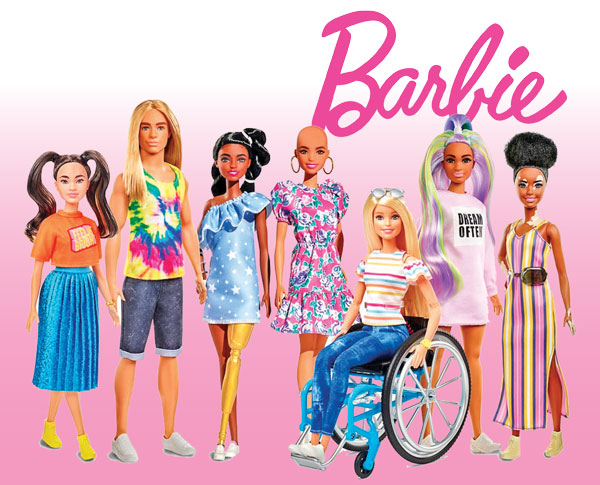You’ve come a long way, Barbie
By Lisa Nicklanovich; photo courtesy of nytimes.com


Mattel is offering a diverse line of Barbies which include a variety of body and skin types as well as dolls reflecting physical disabilities. In an effort to inspire young girls, Mattel launched the Dream Gap project in 2018, a global initiative giving girls the resources and support they need to continue believing in themselves and honors global female role models.
There are many opinions about the Barbie doll, but six decades after her invention by Ruth Handler, co-founder of toy manufacturer Mattel, she’s still the number one fashion doll in the United States. According to Mattel, 90% of American girls own at least one Barbie before age 11. Barbie is available in 150 countries and the Barbie brand has over 99% brand awareness globally – her influence is enormous.
The affordable doll with blonde hair and disproportionate body measurements is being strategically reinvented. Barbie, according to Mattel, is now the most diverse fashion doll on the market.
Since Barbie’s Fashionista line launched five years ago, Mattel has added a wide variety of dolls which is probably part business and part public demand. There are currently 176 dolls available, both male and female, with nine different body types, 35 skin tones, and 94 hairstyles. A curvy doll with an afro? Yes, that is Barbie.
In the 2020 line of Fashionistas, the new additions include a doll with vitiligo, a condition that causes loss of skin color in blotches, which many became aware of through the rise of model Winnie Harlow. Dolls reflecting physical disabilities have been added, including a doll with a wheelchair and a doll with a prosthetic leg.
Ken is now offered with long hair, replacing the plastic hair of the past, and he has new body types, skin tones and a range of diverse features including a man bun, cornrows, and freckles.
Clothes and accessories are being updated as well, with both feminine and masculine-presenting options so that kids can mix and match and create a diversity of representations of gender expression.
The Barbie Fashionista Breathe With Me Barbie will be featured in another new project coming in the spring called the Barbie Wellness Collection. Mattel partnered with meditation app Headspace to guide young girls through five different meditations.
While some studies have suggested there is a “Barbie effect”— that young girls’ views on body image are influenced by playing with the doll, Mattel’s many new diverse offerings are providing options beyond the icon.
Research shows that starting at age 5, many girls develop self-limiting beliefs and begin to think they’re not as smart and capable as boys, which is known as the Dream Gap. Imaginative play sparks creativity, helping young girls prepare for their future as they practice and pretend various roles and situations, closing the Dream Gap.
While Barbie has had more than 200 inspirational careers, one of the newest being Film Director Barbie, she is not a character like Elsa from the Disney film “Frozen” with a backstory. Barbie is given a voice and a story by the child who plays with her so she can imagine being anything she wants to be. In a world where children are abandoning toys for digital devices, this more inclusive line may encourage imaginative play.
With International Women’s Day on March 8, it is a good opportunity to honor as many role models as we can for young girls, encourage inclusivity and promote body positivity and health.